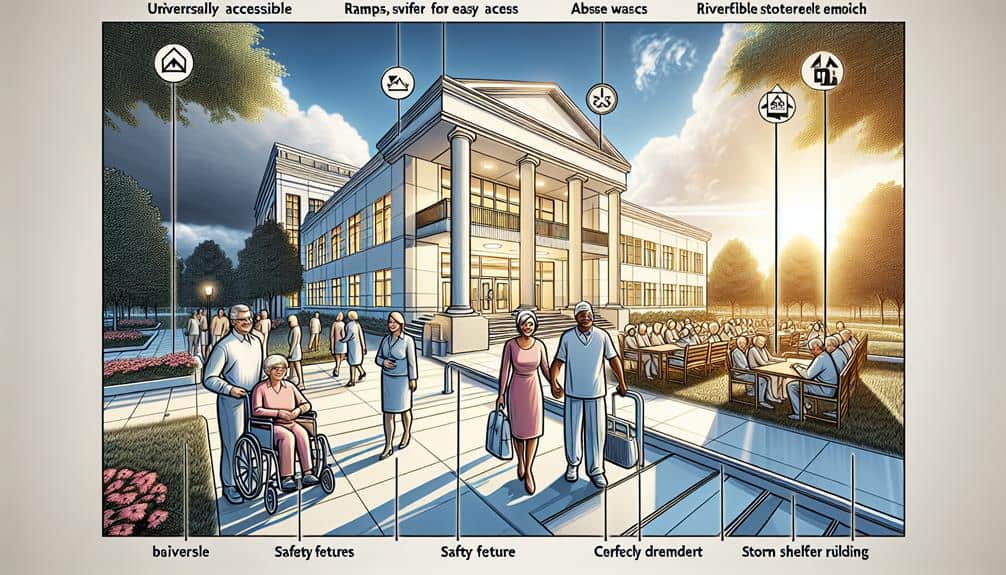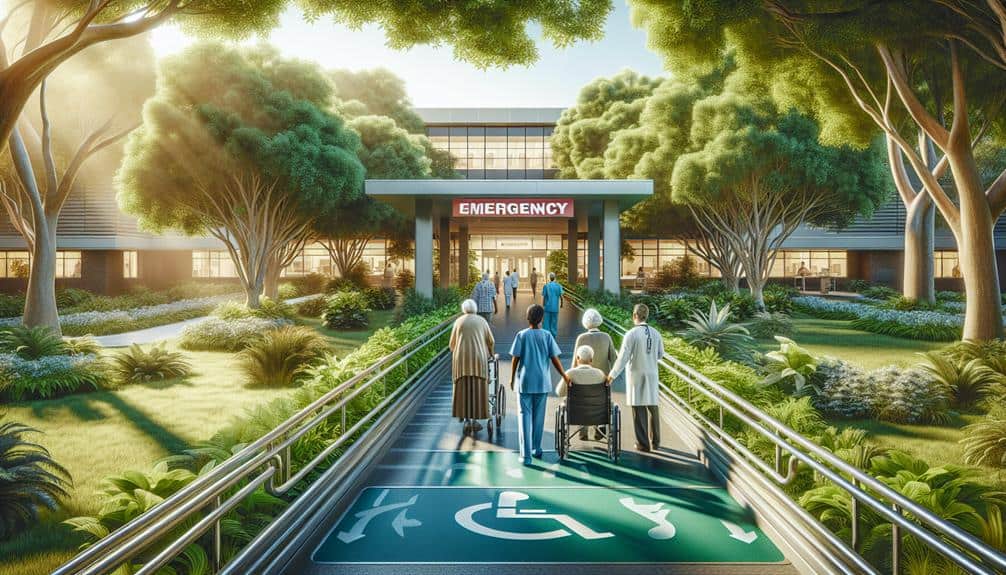When we consider storm shelter locations for seniors, several options stand out. Community centers and local government buildings are accessible and typically equipped with emergency supplies and trained staff. Senior living facilities often have mobility-friendly modifications, while public libraries provide safety features and community support. Churches and religious centers offer comfort in familiar settings, and hospitals are ideal for those needing medical care. Schools and universities also have strong infrastructure and emergency plans for seniors. Each location provides unique benefits tailored to senior needs, making them invaluable during storms. Let's explore further to see which might suit your needs best.
Key Points
- Community centers offer familiar, accessible storm shelters with trained staff and social activities for seniors.
- Senior living facilities prioritize mobility accommodations and emergency planning for swift and safe evacuations.
- Public libraries provide accessible shelters with safety features and emergency kits, plus community support services.
- Churches and religious centers offer senior-accommodating shelters with spiritual support and volunteer assistance.
Community Centers
Community centers often serve as accessible and reliable storm shelters for seniors in emergency situations. These centers are typically located in familiar areas, making them easy for seniors to reach quickly. More than just shelters, community centers offer a range of recreation activities that can keep spirits high during stressful times. Whether it's a game of bingo or a light exercise class, these activities provide both physical and mental relief.
Social engagement is another significant benefit these centers offer. During emergencies, isolation can be a major issue for seniors, impacting their mental well-being. At community centers, seniors have the opportunity to interact with peers and share experiences, fostering a sense of community even amid crises. The presence of friends and familiar faces can be comforting, alleviating anxiety and stress.
Moreover, community centers often have staff trained in emergency response, ensuring that seniors receive the care and attention they need. The sense of security, coupled with engaging activities and social opportunities, makes community centers a valuable resource. They not only provide physical safety but also contribute to emotional and mental well-being, empowering seniors to maintain their independence and freedom even in challenging times.
Senior Living Facilities
Let's examine how senior living facilities provide storm shelter options.
We need to assess in-house shelter accessibility and their proximity to emergency services to guarantee seniors' safety.
These factors are critical when evaluating the preparedness of these facilities.
In-House Shelter Accessibility
Maintaining in-house shelter accessibility in senior living facilities is crucial for the safety and well-being of elderly residents during severe weather events. We need to focus on home modifications and reliable transportation options to guarantee that our seniors are well-protected.
First, let's consider home modifications. It's essential that these shelters are equipped with features that cater to mobility issues, like ramps, handrails, and non-slip flooring. Elevators should be in good working order, and emergency lighting should be installed to guide residents during power outages. It's also important that these shelters are located on the ground floor to make them easily accessible without the need for stair navigation.
In terms of transportation options, having a clear and efficient plan is key. Whether it's a facility-owned shuttle service or a partnership with a local transportation company, there should be reliable ways to move residents quickly if necessary. Emergency drills and clear communication plans will help guarantee everyone knows where to go and how to get there.
Proximity to Emergency Services
While in-house shelter accessibility addresses immediate safety, the closeness of senior living facilities to emergency services plays an equally crucial role in safeguarding residents during severe weather events. Rapid emergency response can make a vital difference in outcomes, especially for seniors who may have mobility or health issues. We need to assess how near these facilities are to hospitals, fire stations, and emergency medical services.
Transportation options are another key factor. In a crisis, the ability to quickly and efficiently transport residents to a safer location or medical facility is essential. Facilities located near major roads or with access to reliable transportation services can greatly enhance safety. Emergency vehicles need unobstructed routes to reach us swiftly, and senior living facilities should prioritize this aspect when choosing their locations.
We should also assess the overall disaster preparedness of the community. Are there established evacuation plans? Is there coordination with local emergency services? These questions help measure how well a senior living facility can protect its residents during severe weather.
Public Libraries

Let's explore how public libraries serve as storm shelters for seniors.
They offer accessible facilities and safety features, ensuring a secure environment.
Additionally, community support services at libraries provide essential resources during emergencies.
Accessibility and Safety Features
Public libraries often feature ramps, elevators, and clearly marked emergency exits to ensure seniors can access storm shelters safely. These accessibility features are vital for emergency preparedness, ensuring that everyone, regardless of mobility, can seek refuge quickly and efficiently.
Libraries are designed with inclusivity in mind, and that extends to their shelter areas. The shelter design typically includes wide doorways, non-slip flooring, and adequate lighting, all of which minimize hazards and make navigation easier for seniors.
We should also consider the significance of clear signage and audible alerts in these public spaces. In an emergency, every second counts, and well-placed signs and alarms help guide seniors to safety without confusion. Many libraries also conduct regular drills and staff training, enhancing their overall readiness. This proactive approach means that when a storm hits, seniors will find a well-prepared environment waiting to protect them.
Additionally, libraries often have emergency kits stocked with essential supplies like water, blankets, and first aid materials. These kits are easily accessible and maintained regularly.
This all-encompassing approach to safety and accessibility makes public libraries a dependable option for seniors seeking shelter during storms.
Community Support Services
Libraries often serve as crucial hubs of community support, particularly for seniors in need of storm shelter. They offer more than just books; they provide safe, accessible spaces designed to serve the community during emergencies. Many libraries have designated areas that double as storm shelters, ensuring seniors have a secure place to stay during severe weather events.
Public libraries frequently collaborate with local agencies to offer senior wellness programs that foster a sense of community and well-being. These programs can range from health screenings to educational workshops on emergency preparedness, equipping seniors with the knowledge they need to stay safe. Libraries also create volunteer opportunities, allowing seniors to stay active and engaged while contributing to their communities. Volunteering can be particularly beneficial for mental and emotional health, providing a sense of purpose and connection.
In times of crisis, libraries become more than just a refuge; they transform into essential centers of support and information. By leveraging their resources and community ties, libraries are uniquely positioned to offer comprehensive assistance to seniors, ensuring they're well-protected and informed.
Let's use these valuable community assets to their full potential, especially when safety is paramount.
Churches and Religious Centers
Many churches and religious centers offer storm shelters specifically designed to accommodate seniors. These locations provide not only physical safety but also an environment rich in community and support.
Here are three reasons why these shelters are an ideal choice for seniors:
- Spiritual Comfort: During a crisis, maintaining a sense of spiritual well-being is essential. Churches and religious centers offer a familiar and comforting atmosphere, which can help reduce anxiety and stress.
- Volunteer Opportunities: Many religious centers are powered by a network of dedicated volunteers. This means that seniors will have access to compassionate, personalized care from individuals who are often members of their own community.
- Accessibility: These centers are often designed to be easily accessible to everyone, including those with mobility issues. This makes them a practical choice for seniors who may have difficulty navigating other types of shelters.
Local Government Buildings

When seeking shelter during a storm, local government buildings offer a reliable and well-equipped option for seniors. These facilities are designed to handle emergencies and often include adequate space, first aid supplies, and basic necessities. Because they're public properties, they're generally accessible and centrally located, making them easy to reach in a hurry.
In comparison to other communal areas like public parks and shopping malls, local government buildings provide a more controlled and secure environment. Public parks, though spacious, lack the structural integrity needed during severe weather. Shopping malls, while convenient, can be crowded and chaotic, making it difficult for seniors to navigate safely. Government buildings, on the other hand, are staffed with trained personnel who can offer assistance and make sure that everyone remains safe.
Moreover, many local government buildings have been retrofitted to meet modern safety standards, including reinforced shelters specifically for storm protection. These buildings often serve as central hubs during emergencies, coordinating relief efforts and disseminating important information.
Schools and Universities
Schools and universities often serve as accessible and well-equipped storm shelters for seniors, providing safe havens during severe weather events. These educational institutions have strong infrastructure and ample space, making them ideal for emergency situations. Let's explore why they're such a great option:
1. University Campuses and Senior Programs:
Many university campuses have senior programs that make them particularly attuned to the needs of the elderly. These programs often include emergency preparedness plans specifically tailored for seniors, making sure that they're well taken care of during a storm.
2. School Facilities and Community Engagement:
Schools frequently engage in elderly outreach programs, fostering strong community ties. This connection ensures that local seniors are aware of the resources available to them and can easily access school facilities when a storm hits.
3. Advanced Infrastructure:
Educational institutions are built to accommodate large numbers of people and often have advanced infrastructure designed to withstand severe weather. This includes reinforced buildings and thorough emergency plans that prioritize the safety of all occupants, including seniors.
Hospitals and Medical Centers

Hospitals and medical centers offer an essential sanctuary for seniors during storms, equipped with advanced medical facilities and trained staff to guarantee their safety. These institutions are designed to handle emergencies and have protocols in place to provide uninterrupted care. For those seniors requiring home care, the shift to a hospital can offer the necessary medical attention they mightn't receive during a storm at home.
We should consider that hospitals and medical centers aren't only about medical emergencies but also about providing a secure environment. Unlike nursing homes, which mightn't have the same level of emergency preparedness, hospitals are equipped with backup power, secure structures, and extensive medical supplies. This makes them a more dependable option during severe weather conditions.
In addition to safety, hospitals have the added benefit of having specialized staff who are trained to deal with senior-specific medical issues. This focus on specialized care can be a significant advantage over other shelter options. For seniors already in need of regular medical attention, relocating to a hospital during a storm can guarantee that their health needs are consistently met, providing peace of mind for both them and their families.
Frequently Asked Questions
What Should Seniors Bring With Them to a Storm Shelter?
What should we bring to a storm shelter? First, let's grab our emergency supplies. It's important. Then, don't forget comfort items like blankets and pillows. These essentials make sure we're safe and comfortable during the storm.
How Can Seniors With Mobility Issues Access Storm Shelters?
Seniors with mobility issues face accessibility challenges. We can address these by making sure shelters have ramps and elevators. Reliable transportation options, like accessible vans, also help guarantee safe, timely access during emergencies.
Are There Pet-Friendly Storm Shelters Available for Seniors With Pets?
Let's cut to the chase. Yes, there are pet-friendly storm shelters. However, pet accommodations vary by location and shelter regulations. It's important to check local guidelines to make sure our furry friends can join us safely.
How Do I Register a Senior for a Storm Shelter in Advance?
To register a senior for a storm shelter in advance, we should contact local emergency preparedness agencies or community resources. They often have online registration forms or hotlines to guarantee timely and secure shelter access.
What Are the Best Ways for Seniors to Stay Informed About Approaching Storms?
We should rely on emergency alerts and community resources to stay informed about approaching storms. Sign up for weather notifications, download reliable apps, and connect with local agencies to get timely updates and guarantee our safety.


